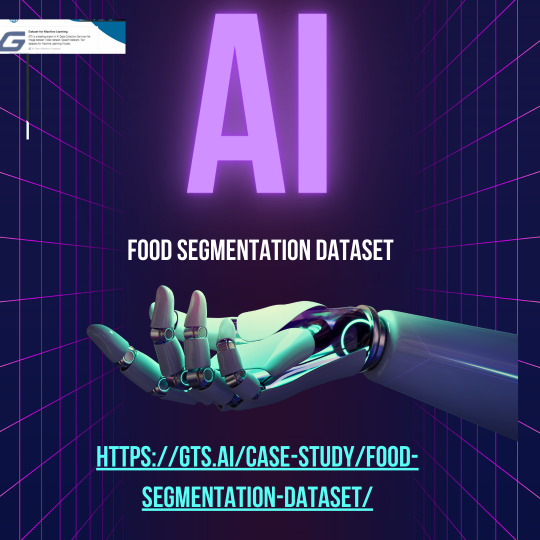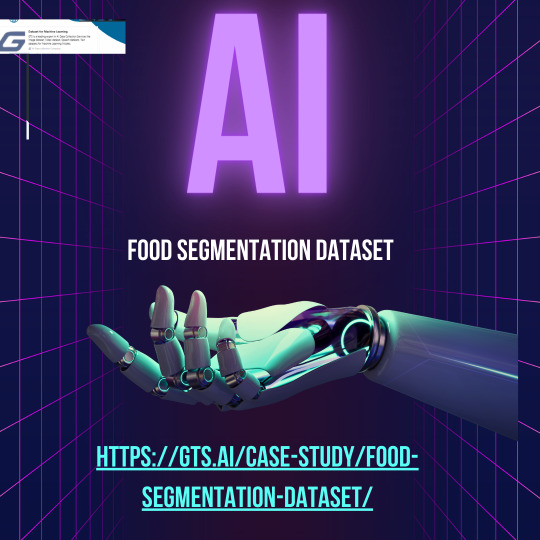#foodsegment
Explore tagged Tumblr posts
Text
Unveiling the Feast: A Comprehensive Guide to Food Segmentation Datasets
Introduction:
In the ever-evolving landscape of computer vision and artificial intelligence, one of the most captivating applications is food segmentation. As the demand for smart solutions in the food industry continues to rise, the need for robust and diverse food segmentation datasets becomes increasingly essential. This blog explores the significance of food segmentation datasets and introduces some of the noteworthy datasets that are fueling advancements in this exciting field.

Why Food Segmentation Datasets Matter:
Food segmentation involves the partitioning of images or videos into distinct regions, with each region corresponding to a specific food item. This process plays a pivotal role in various applications, such as automated food recognition, dietary analysis, and restaurant menu digitization. To train accurate and reliable models for these applications, a high-quality and diverse food segmentation dataset is indispensable.
Key Characteristics of an Ideal Food Segmentation Dataset:
Diversity of Food Types:
A comprehensive dataset should cover a wide range of cuisines, dishes, and food types to ensure that the model is versatile and capable of recognizing various foods.
Varied Backgrounds and Settings:
Food is often photographed in different environments, from restaurants to home kitchens. A dataset should include images with diverse backgrounds, lighting conditions, and perspectives to enhance the model's adaptability.
Annotated Ground Truth:
Accurate annotation is crucial for training machine learning models. A reliable food segmentation dataset should provide pixel-level annotations, indicating the boundaries of individual food items in the images.
Large Scale:
To train deep learning models effectively, a dataset should be large enough to capture the complexity and diversity of real-world scenarios. This enables the model to generalize well to new, unseen data.
Open Access:
Accessibility is vital for fostering research and innovation. Openly sharing food segmentation datasets encourages collaboration and accelerates progress in the field.
Noteworthy Food Segmentation Datasets:
Food-101:
Overview: Food-101 is a widely used dataset that consists of 101,000 images across 101 food categories.
Features: It covers a diverse range of cuisines and is suitable for both food recognition and segmentation tasks.
Foodseg:
Overview: Foodseg is a dataset specifically curated for food segmentation. It includes high-resolution images with pixel-level annotations for various foods.
Features: With a focus on segmentation, Foodseg is valuable for training models dedicated to precisely delineating food boundaries.
UNICT-FD889:
Overview: UNICT-FD889 is a large-scale dataset comprising 889 food categories with over 300,000 images.
Features: Its extensive coverage makes it a valuable resource for researchers and practitioners working on food-related computer vision tasks.
Conclusion:
As the field of food segmentation continues to flourish, the role of high-quality datasets cannot be overstated. These datasets not only fuel research and development but also pave the way for innovative solutions in the realms of food recognition, dietary analysis, and beyond. By staying abreast of the latest datasets and contributing to their growth, researchers and developers can collectively enhance the capabilities of food segmentation models, bringing us closer to a future where technology seamlessly interacts with the culinary world.
How GTS.AI Can Help You?
At Globose Technology Solutions Pvt Ltd (GTS), data collection is not service;It is our passion and commitment to fueling the progress of AI and ML technologies.GTS.AI can leverage natural language processing capabilities to understand and interpret human language. This can be valuable in tasks such as text analysis, sentiment analysis, and language translation.GTS.AI can be adapted to meet specific business needs. Whether it's creating a unique user interface, developing a specialised chatbot, or addressing industry-specific challenges, customization options are diverse.
0 notes
Video
youtube
Egg Fried Rice Recipe/ویجیٹیبل ایگ فرائیڈ رائس /Homemade chicken,egg, ve...
#chinese#chinese rice#chinesecuisine#recipe#foodsegment#food segment#food fusion#cooking#chef#homemade#homemade recipe#rice recipes#fried recipes#green peas#vegetables#manchurian#capsicum#cabbage
2 notes
·
View notes
Text
Unveiling the Feast: A Comprehensive Guide to Food Segmentation Datasets
Introduction:
In the ever-evolving landscape of computer vision and artificial intelligence, one of the most captivating applications is food segmentation. As the demand for smart solutions in the food industry continues to rise, the need for robust and diverse food segmentation datasets becomes increasingly essential. This blog explores the significance of food segmentation datasets and introduces some of the noteworthy datasets that are fueling advancements in this exciting field.

Why Food Segmentation Datasets Matter:
Food segmentation involves the partitioning of images or videos into distinct regions, with each region corresponding to a specific food item. This process plays a pivotal role in various applications, such as automated food recognition, dietary analysis, and restaurant menu digitization. To train accurate and reliable models for these applications, a high-quality and diverse food segmentation dataset is indispensable.
Key Characteristics of an Ideal Food Segmentation Dataset:
Diversity of Food Types:
A comprehensive dataset should cover a wide range of cuisines, dishes, and food types to ensure that the model is versatile and capable of recognizing various foods.
Varied Backgrounds and Settings:
Food is often photographed in different environments, from restaurants to home kitchens. A dataset should include images with diverse backgrounds, lighting conditions, and perspectives to enhance the model's adaptability.
Annotated Ground Truth:
Accurate annotation is crucial for training machine learning models. A reliable food segmentation dataset should provide pixel-level annotations, indicating the boundaries of individual food items in the images.
Large Scale:
To train deep learning models effectively, a dataset should be large enough to capture the complexity and diversity of real-world scenarios. This enables the model to generalize well to new, unseen data.
Open Access:
Accessibility is vital for fostering research and innovation. Openly sharing food segmentation datasets encourages collaboration and accelerates progress in the field.
Noteworthy Food Segmentation Datasets:
Food-101:
Overview: Food-101 is a widely used dataset that consists of 101,000 images across 101 food categories.
Features: It covers a diverse range of cuisines and is suitable for both food recognition and segmentation tasks.
Foodseg:
Overview: Foodseg is a dataset specifically curated for food segmentation. It includes high-resolution images with pixel-level annotations for various foods.
Features: With a focus on segmentation, Foodseg is valuable for training models dedicated to precisely delineating food boundaries.
UNICT-FD889:
Overview: UNICT-FD889 is a large-scale dataset comprising 889 food categories with over 300,000 images.
Features: Its extensive coverage makes it a valuable resource for researchers and practitioners working on food-related computer vision tasks.
Conclusion:
As the field of food segmentation continues to flourish, the role of high-quality datasets cannot be overstated. These datasets not only fuel research and development but also pave the way for innovative solutions in the realms of food recognition, dietary analysis, and beyond. By staying abreast of the latest datasets and contributing to their growth, researchers and developers can collectively enhance the capabilities of food segmentation models, bringing us closer to a future where technology seamlessly interacts with the culinary world.
How GTS.AI Can Help You?
At Globose Technology Solutions Pvt Ltd (GTS), data collection is not service;It is our passion and commitment to fueling the progress of AI and ML technologies.GTS.AI can leverage natural language processing capabilities to understand and interpret human language. This can be valuable in tasks such as text analysis, sentiment analysis, and language translation.GTS.AI can be adapted to meet specific business needs. Whether it's creating a unique user interface, developing a specialised chatbot, or addressing industry-specific challenges, customization options are diverse.
0 notes
Video
youtube
Naan Khatai |خستہ اور مزیدار نان ختائی | नान खताौ |Homemade basic Naan K...
1 note
·
View note